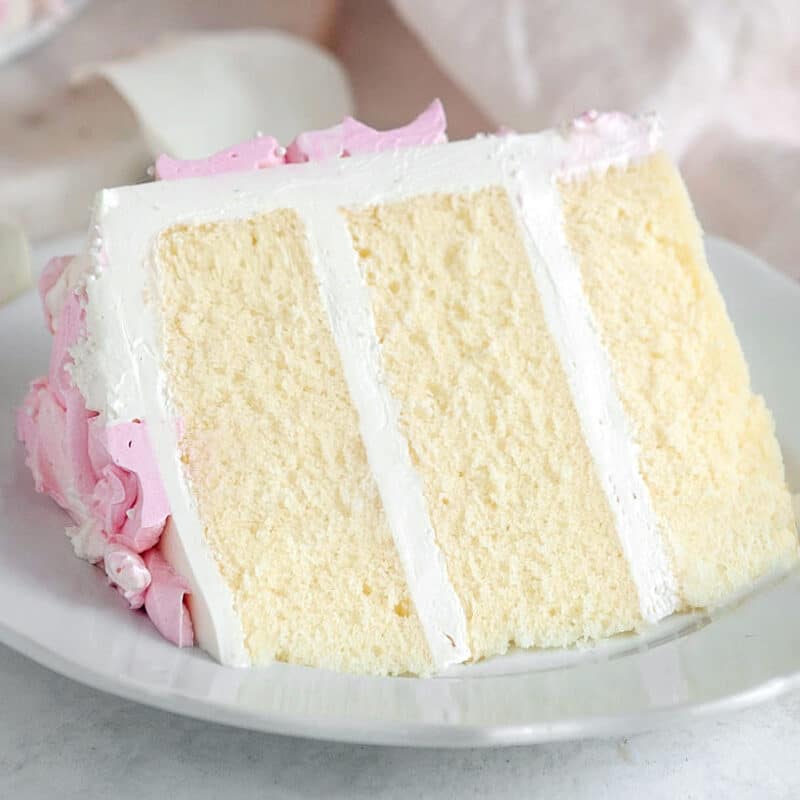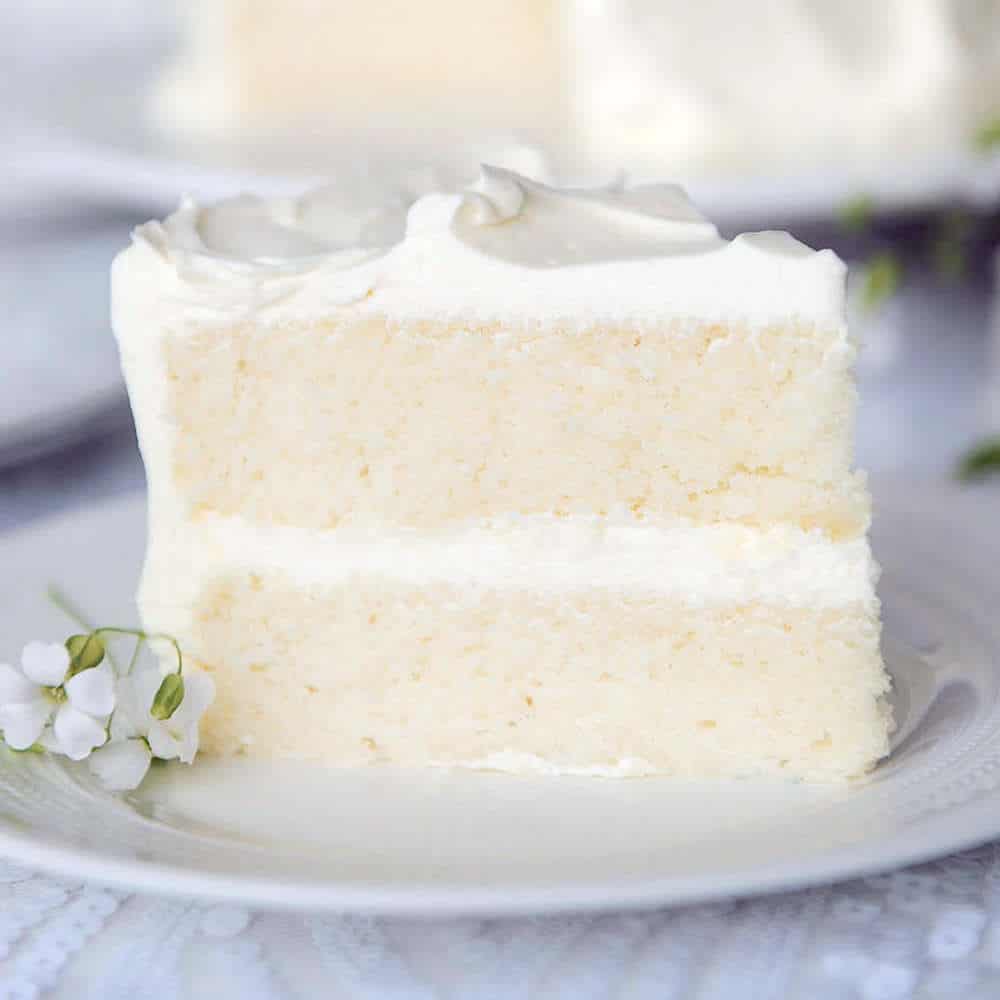Indulge in the timeless classic of baking—the white vanilla cake. This versatile and delectable dessert has graced countless celebrations and gatherings, leaving a trail of sweet memories in its wake. Join us on a culinary journey as we explore the secrets of crafting the perfect white vanilla cake, from gathering the finest ingredients to mastering essential baking techniques.
Whether you’re a seasoned baker or a novice eager to embark on a new adventure, this guide will equip you with the knowledge and confidence to create a white vanilla cake that will tantalize your taste buds and impress your loved ones.
So gather your ingredients, preheat your oven, and let’s embark on a delightful baking escapade.
Ingredients

To craft a delectable white vanilla cake, gather the following essential ingredients:
Flour: 2 1/4 cups (281 grams) of all-purpose flour, sifted for a light and airy texture.
Sugar: 2 cups (400 grams) of granulated sugar, providing sweetness and structure.
Baking powder: 3 1/2 teaspoons (17 grams) of baking powder, the leavening agent that will give your cake its lift.
Baking soda: 1 teaspoon (5 grams) of baking soda, working in conjunction with the baking powder for optimal rise.
Salt: 1/2 teaspoon (3 grams) of salt, balancing the sweetness and enhancing flavor.
Unsalted butter: 1 cup (2 sticks or 227 grams), softened to room temperature for easy creaming.
Vegetable oil: 1/2 cup (120 milliliters), adding moisture and tenderness.
Eggs: 3 large eggs, at room temperature for better emulsification.
Vanilla extract: 2 teaspoons (10 milliliters) of pure vanilla extract, imparting a classic and aromatic flavor.
Milk: 1 cup (240 milliliters) of whole milk, contributing richness and moisture.
Optional Ingredients and Substitutes
For variations, consider these optional ingredients or substitutes:
- Sour cream: 1 cup (240 milliliters) of sour cream may be substituted for milk, adding a tangy flavor and moist texture.
- Buttermilk: 1 cup (240 milliliters) of buttermilk can also be used instead of milk, resulting in a slightly tangy and fluffy cake.
- Vanilla bean paste: 1 teaspoon (5 grams) of vanilla bean paste can be used instead of vanilla extract for a more intense vanilla flavor.
Steps
Preparing a delicious white vanilla cake involves a series of meticulous steps. By following these steps carefully, you can create a moist, fluffy, and flavorful cake that will impress your taste buds.
Mixing Wet Ingredients
In a large bowl, whisk together the softened unsalted butter and granulated sugar until light and fluffy. This process should take approximately 5 minutes using an electric mixer on medium speed. Once the mixture is light and airy, beat in the eggs one at a time, mixing well after each addition.
Preparing the Batter
In a separate bowl, whisk together the all-purpose flour, baking powder, baking soda, and salt. Gradually add the dry ingredients to the wet ingredients, mixing until just combined. Avoid overmixing the batter, as this can result in a tough cake.
Baking
Preheat your oven to 350°F (175°C). Grease and flour a 9×13 inch baking pan. Pour the batter into the prepared pan and bake for 30-35 minutes, or until a toothpick inserted into the center comes out clean.
Baking Techniques
The techniques used in baking the white vanilla cake are crucial for achieving its desired texture and flavor. These techniques include creaming butter and sugar, folding in dry ingredients, and ensuring even baking.
Creaming butter and sugar together is an essential step in baking cakes. It incorporates air into the batter, which results in a light and fluffy texture. Folding in dry ingredients gently ensures that the batter does not deflate and that the ingredients are evenly distributed.
Ensuring Even Baking
Ensuring even baking is vital for preventing the cake from having a dense or uneven texture. To achieve this, the cake should be placed in the center of the oven and rotated halfway through the baking time. Additionally, a toothpick inserted into the center of the cake should come out clean when the cake is done baking.
Variations and Adaptations
Transform your white vanilla cake into a culinary masterpiece by experimenting with endless variations. Adapt it to suit your preferences, dietary needs, and the occasion.
Flavor Enhancements
- Infuse the batter with aromatic spices like cinnamon, nutmeg, or cardamom for a warm and inviting flavor.
- Add citrus zest (lemon, orange, or lime) for a refreshing burst of brightness.
- Enhance the sweetness with a touch of vanilla extract, maple syrup, or honey.
Frosting and Fillings
- Create a classic buttercream frosting with butter, powdered sugar, and vanilla extract.
- Indulge in a rich cream cheese frosting, adding a hint of lemon or strawberry for a tangy twist.
- Delight in a luscious chocolate ganache, melting chocolate and cream together for a velvety smooth finish.
Pan Size Adjustments
- For a smaller cake, reduce the ingredients by half and bake in an 8-inch pan.
- For a larger cake, double the ingredients and bake in a 12-inch pan.
- Adjust the baking time accordingly, checking for doneness with a toothpick inserted into the center.
Dietary Considerations
- For a gluten-free cake, replace all-purpose flour with a gluten-free flour blend.
- For a dairy-free cake, substitute butter and milk with dairy-free alternatives.
- For a vegan cake, use plant-based milk, eggs, and butter substitutes.
Presentation and Serving
A white vanilla cake is a versatile dessert that can be presented and served in a variety of ways to suit any occasion. Traditional presentations include a simple, frosted cake, while creative options can incorporate intricate designs, decorations, and unique serving methods.
For a classic presentation, frost the cake with a smooth layer of vanilla buttercream and decorate with sprinkles or piped designs. Alternatively, for a more sophisticated look, consider a naked cake with exposed layers of cake and frosting, adorned with fresh fruit or edible flowers.
Garnishing and Decorating
Garnishing and decorating a white vanilla cake can elevate its visual appeal and make it a centerpiece for any celebration. Consider using fresh berries, sliced almonds, or chopped pistachios to add pops of color and texture. Edible flowers, such as roses or violets, can also be used to create an elegant touch.
Accompaniments and Serving Suggestions
White vanilla cake pairs well with a variety of accompaniments, including fresh fruit, ice cream, or whipped cream. For a more indulgent treat, serve it with a drizzle of caramel or chocolate sauce. When serving, consider using a cake stand or pedestal to showcase the cake’s beauty and make it the focal point of your dessert spread.
Summary

As we conclude our exploration of the white vanilla cake recipe, remember that baking is an art form that invites experimentation and personal touches. Don’t be afraid to adjust the flavors, frostings, and decorations to suit your preferences and create a cake that truly reflects your unique style.
May your white vanilla cake become a cherished tradition, bringing joy and sweetness to every occasion.
FAQ
Q: What is the secret to achieving a moist and fluffy white vanilla cake?
A: The key to a moist and fluffy cake lies in properly creaming the butter and sugar until light and fluffy. This incorporates air into the batter, resulting in a tender and airy crumb.
Q: How can I prevent my cake from sinking in the middle?
A: To avoid a sunken cake, ensure that your oven is preheated to the correct temperature and that you do not overmix the batter. Overmixing can develop the gluten in the flour, leading to a tough and dense cake.
Q: Can I substitute all-purpose flour for cake flour in this recipe?
A: While all-purpose flour can be used, cake flour is preferred as it has a lower protein content, resulting in a more tender and delicate crumb.
